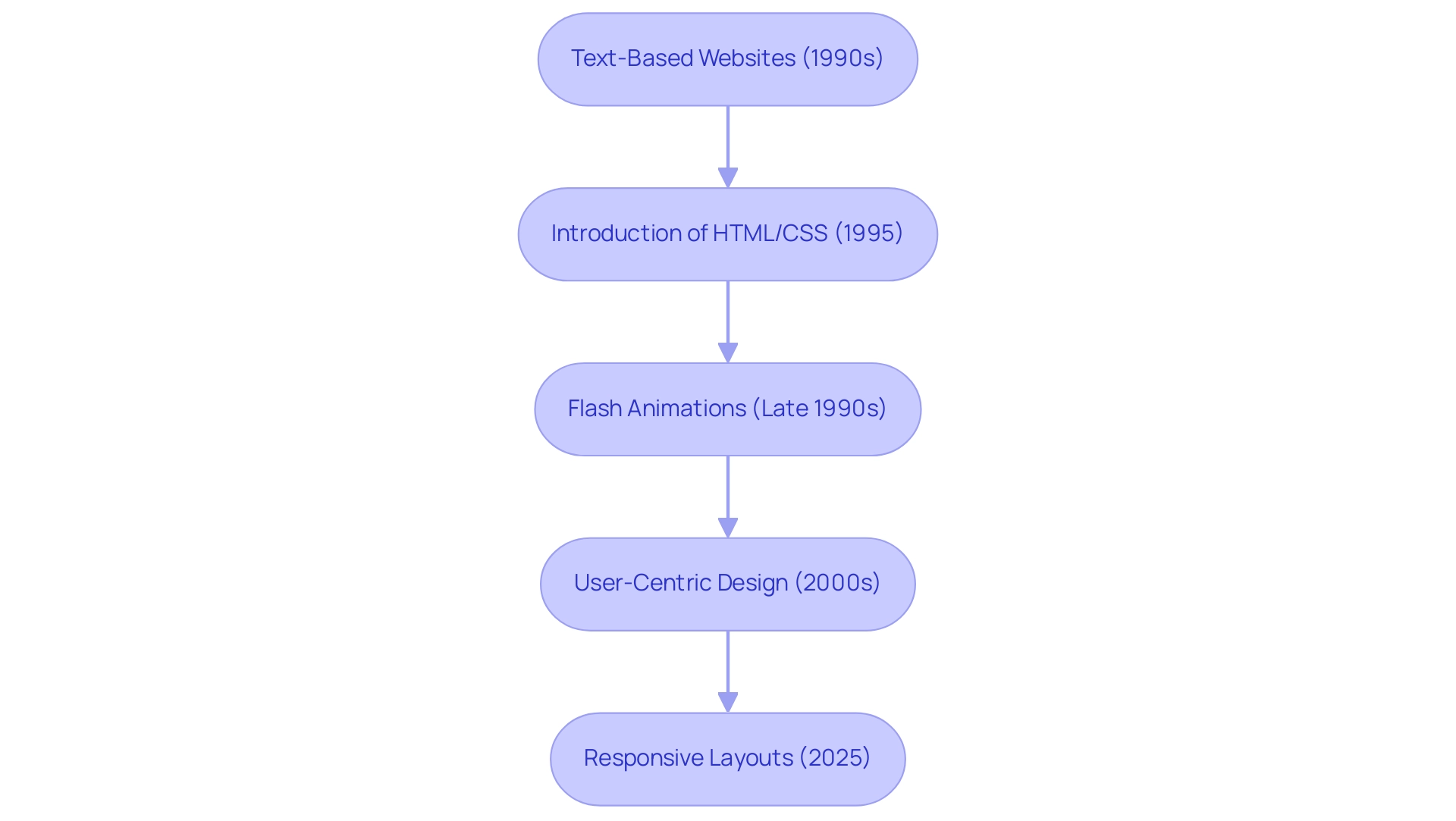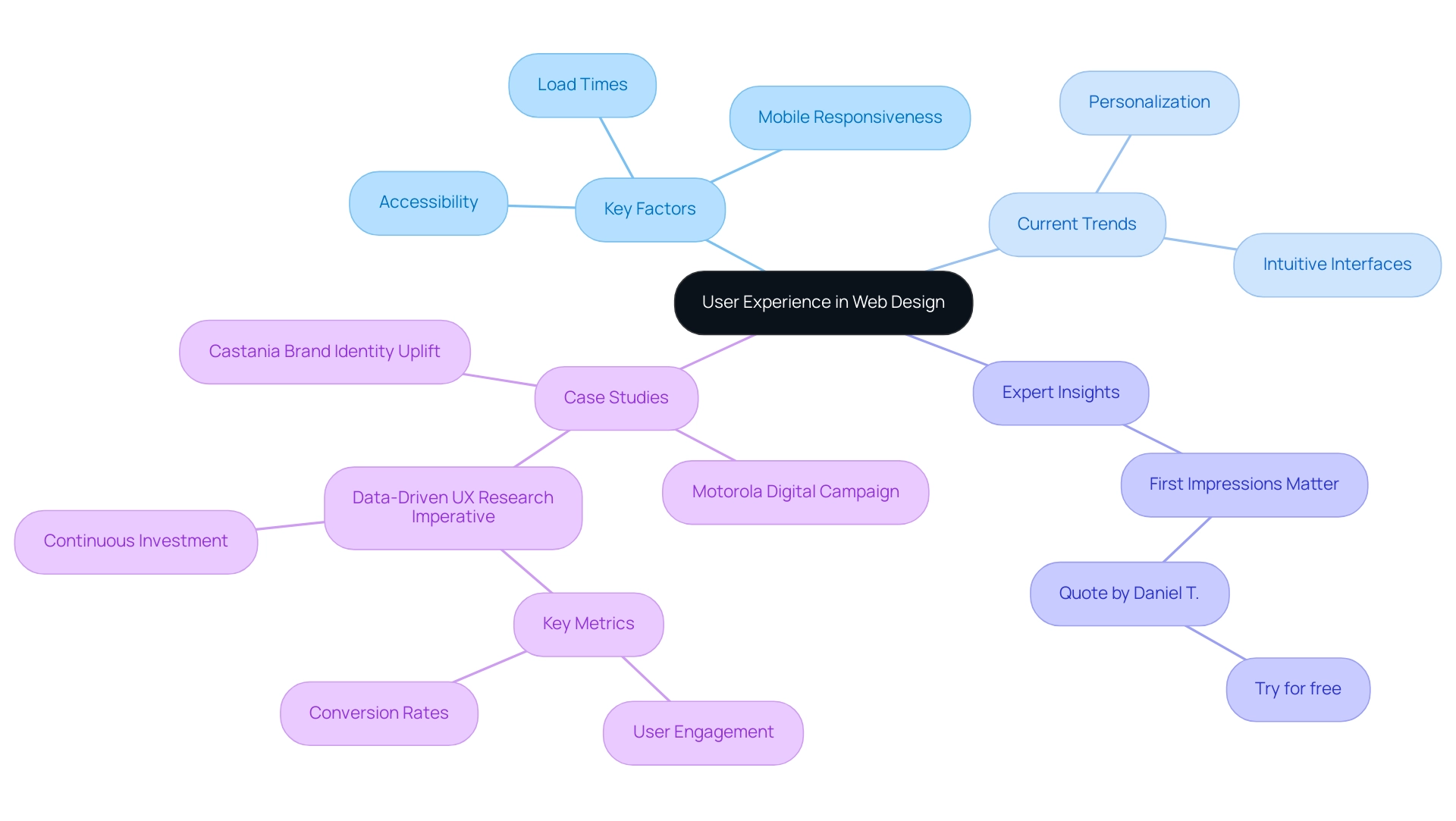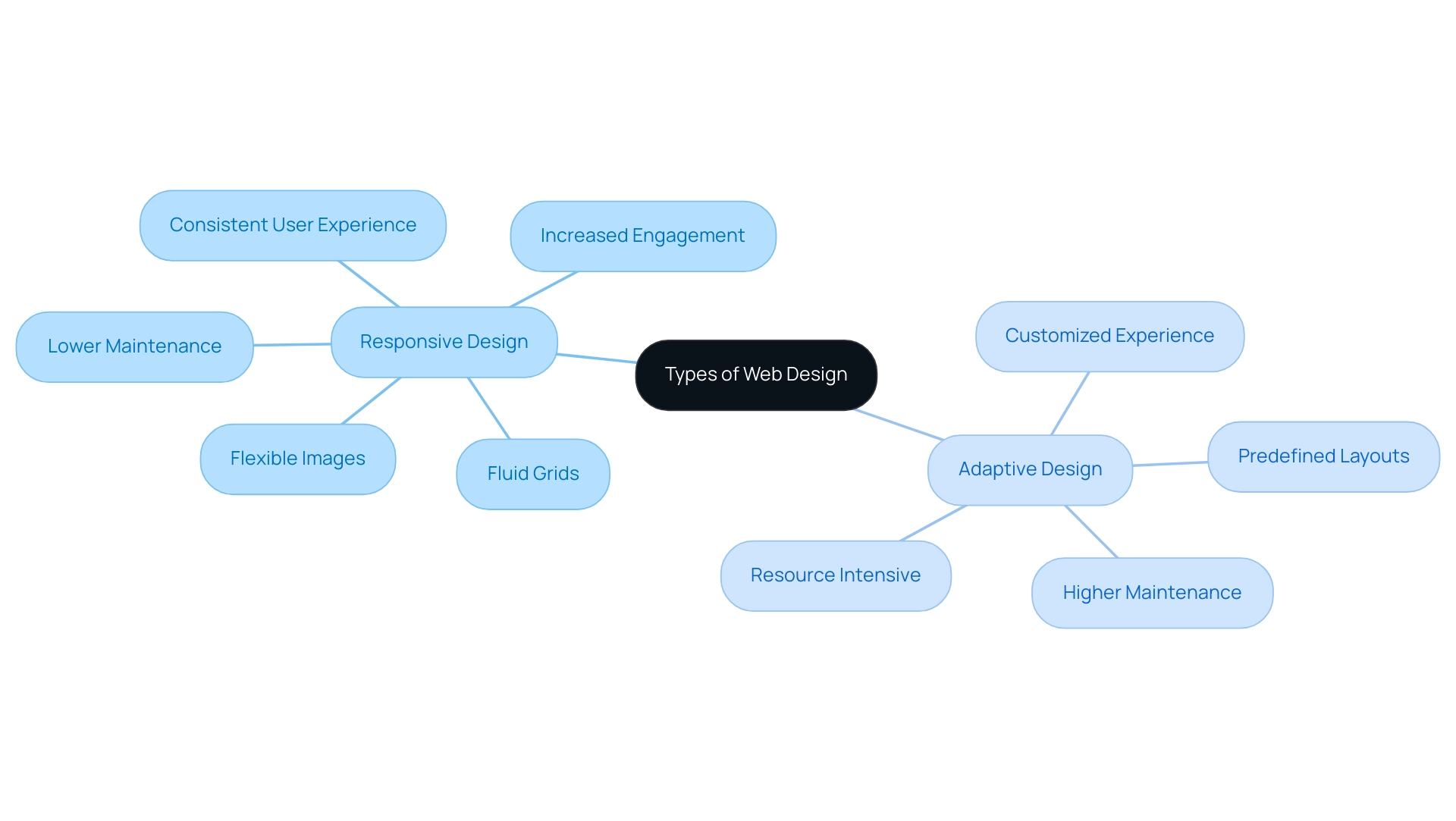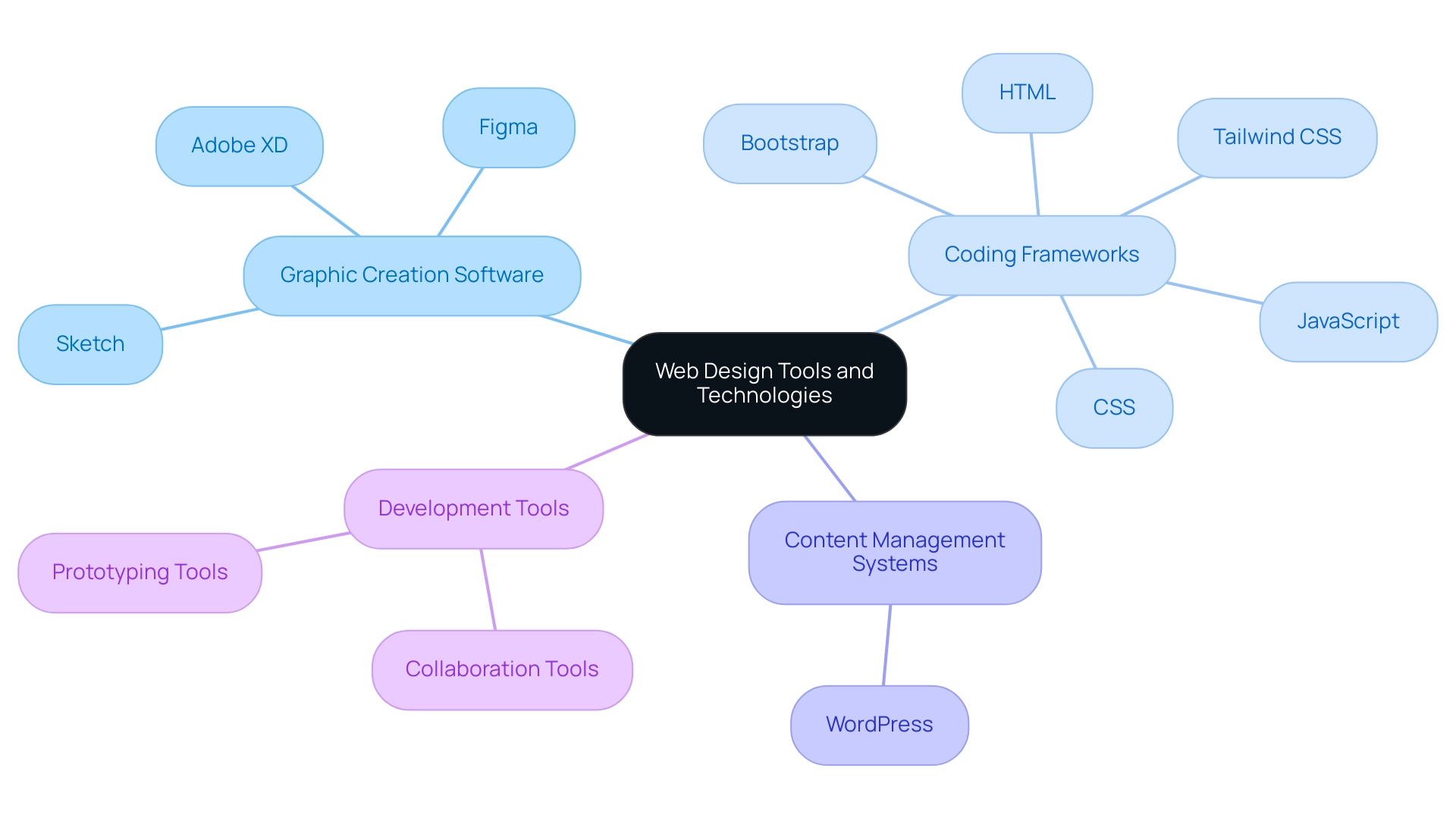General
What Is Web Design Definition? A Comprehensive Overview
Overview
Web design represents a comprehensive process of planning and developing websites, where both aesthetic appeal and functionality converge to enhance user experience and effectively convey a brand’s message. This definition is supported by a detailed exploration of key elements such as:
- Layout
- Color scheme
- User experience
Each of these components plays a critical role in engaging users and driving business results in an increasingly digital landscape. As Brand Managers navigate this complex environment, understanding the interplay of these elements becomes essential for crafting effective digital strategies.
Introduction
In a rapidly evolving digital landscape, the significance of web design is more pronounced than ever. As businesses strive to capture the attention of increasingly discerning online users, the fusion of aesthetics and functionality becomes paramount. Effective web design transcends the mere crafting of visually appealing sites; it is a strategic endeavor that profoundly influences user experience, brand perception, and, ultimately, business success.
With the rise of eCommerce and mobile browsing, understanding the intricacies of web design—from responsive layouts to user-centric interfaces—has become essential for brands aiming to thrive in a competitive marketplace. This article delves into the multifaceted world of web design, exploring its evolution, key elements, and the pivotal role it plays in shaping user interactions and driving engagement.
Understanding Web Design: A Definition
The intricate process of planning and developing websites, referred to as the web design definition, encompasses a variety of elements such as layout, content production, and graphic artistry. This multifaceted discipline not only focuses on the aesthetic appeal of a website but also its functionality, ensuring that it is both visually captivating and user-friendly. Effective website creation is essential for improving user experience and plays a vital role in conveying a company’s message and values.
In today’s digital environment, where eCommerce sites represent around 14% of all websites, understanding the web design definition is crucial; the significance of a well-crafted site cannot be overstated. Recent statistics indicate that more than a third of agencies charge between $1,000 and $1,500 for website creation, with 80.7% of projects typically taking about a month to finish. This investment highlights the increasing recognition of the web design definition as a crucial element of branding strategies, as a well-executed layout can significantly enhance a company’s visibility and consumer connection.
Notable case studies, such as the comprehensive campaigns developed for Mirinda and Quaker Oats, illustrate how effective website strategies can enhance visibility and consumer connection. These campaigns focused on engaging material and influential experiences, showcasing the power of creativity in fostering customer loyalty. Furthermore, the identity enhancement for Castania and the digital initiative for Motorola demonstrate quantifiable results that underscore the effectiveness of strategic web design definition in achieving branding objectives.
As we progress into 2025, recent trends in web development stress the importance of user-friendly interfaces that emphasize accessibility and responsiveness. According to industry insights, websites featuring eye-catching visual components can hold visitors’ attention an average of 47% longer than those that rely heavily on text. This underscores the essential role that layout plays in maintaining user involvement and increasing conversions, consistent with WonderEight’s strategy for developing visually attractive and strategically effective websites.
In conclusion, the web design definition transcends mere appearance; it is a tactical instrument that shapes identity and influences user perceptions. By understanding the latest trends and implementing effective creative strategies, brands can cultivate an engaging online presence that resonates with their target audience, ultimately driving business results.
The Evolution of Web Design: From Past to Present
The evolution of web design has undergone significant transformations since the inception of the internet. Initially, websites were predominantly text-based, offering minimal visual appeal. However, the advent of HTML and CSS marked a pivotal moment in web design, enabling designers to create more sophisticated and visually engaging layouts.
By the late 1990s and early 2000s, technologies like Flash animations gained popularity, allowing for dynamic content and intricate layouts. Yet, as the web matured, the focus shifted towards usability and accessibility, aligning with the web design definition and leading to a more user-centric approach.
In 2025, approximately 80% of websites employ responsive layouts, a testament to the industry’s dedication to ensuring optimal experiences across various devices. This shift reflects a broader trend where the needs and preferences of users dictate choices in creation. Experts in web development have noted that this evolution is not merely about aesthetics; it is about creating functional and accessible experiences that resonate with audiences.
A study by Adobe found that “59% of consumers prefer beautifully crafted websites over simple websites,” underscoring the critical role of aesthetics in web creation.
Historical insights reveal that the first favicons were introduced in 1999, serving as a branding tool for websites and highlighting the significance of visual identity in web creation. Furthermore, in the early 2000s, DSL and cable internet service speeds varied from 128 Kbps to 1.5 Mbps, greatly impacting the development capabilities and user experiences of that period. As companies adjust to evolving trends, they increasingly emphasize responsive and flexible approaches to boost engagement and retention.
Case studies, such as the comprehensive campaigns carried out by WonderEight for brands like Miranda and Quaker Oats, demonstrate how effective web strategies can enhance brand loyalty and consumer engagement. These campaigns utilized innovative styling methods to produce compelling content that connects with intended audiences, reflecting the evolution of trends and consumer preferences.
As technology continues to evolve, so too does the web design definition, with emerging trends and tools shaping the future landscape. The influence of technology on website creation is significant, prompting ongoing innovation and adjustment in reaction to audience expectations and market requirements. Furthermore, platforms like DeviantArt have inspired experimentation in website creation, encouraging creators to push creative boundaries and explore new possibilities.

Key Elements of Effective Web Design
The definition of web design underscores that effective website creation hinges on several essential components that significantly influence audience engagement and brand perception. These elements encompass:
- Layout
- Color scheme
- Typography
- Imagery
- Navigation
A well-structured layout not only directs users through the content but also enhances usability, ensuring that visitors can effortlessly access the information they require.
In fact, over 84% of visitors prefer mobile websites, highlighting the necessity for responsive layouts that adapt seamlessly to various devices. As Jordana Alexandrea, Senior Content Writer at Hostinger, aptly notes, “With mobiles driving over half of web traffic, a responsive site can significantly increase customer satisfaction, retention, and conversions.”
The selection of a color scheme is particularly impactful; it enhances visual appeal and reinforces brand recognition. Research suggests that color can improve recognition by up to 80%, making it a critical factor in the web design definition. Brands like Coca-Cola and Airbnb effectively leverage color schemes to evoke emotions and create memorable experiences for consumers.
Typography is another pivotal element that enhances readability and conveys the brand’s personality. Appropriate font selections can elevate the user experience, with studies revealing that 30% of small business owners intend to incorporate more video content on their websites, signaling a shift towards more engaging formats that complement textual content.
High-quality imagery is essential for capturing attention and eliciting emotions, while intuitive navigation ensures users can easily locate the information they seek. A case study featuring Quaker Oats illustrates this effectively; WonderEight executed a comprehensive marketing campaign that employed successful web creation principles, resulting in significant experiences that resonated with consumers and bolstered Quaker Oats’ market position.
In 2025, the significance of these elements remains critical. Experts emphasize that the web design definition encompasses a cohesive and engaging user experience, which not only reflects the organization’s identity but also drives customer satisfaction and retention. Given that mobile devices account for more than 77% of searches, prioritizing a responsive layout that incorporates these key components is essential for companies aiming to thrive in the digital landscape.
Moreover, with Google Lens being utilized 12 billion times a month as of May 2023, the trend towards mobile engagement continues to expand, underscoring the necessity for brands to adapt their web strategies accordingly.

The Role of User Experience in Web Design
User experience (UX) is pivotal to the web design definition, influencing every facet of an individual’s interaction with a website. It encompasses not only the ease of navigation but also the emotional responses triggered by design elements. A well-crafted UX can significantly enhance satisfaction, leading to increased engagement and improved conversion rates.
In fact, businesses lacking a website risk losing up to 80% of potential customers, underscoring the necessity of a strong online presence.
To create a seamless experience, designers must prioritize several key factors, including:
- Load times
- Mobile responsiveness
- Accessibility
Companies that have invested in optimizing their UX have seen remarkable improvements in conversion rates. Significant instances include the digital campaign for Motorola, which effectively employed UX principles to improve engagement and drive measurable outcomes, along with the identity enhancement for Castania, demonstrating the effectiveness of strategic UX.
Current trends in UX creation for 2025 emphasize the significance of personalization and intuitive interfaces, which are proven to enhance user satisfaction and loyalty. Good UX not only fosters customer retention but also promotes word-of-mouth marketing, further amplifying brand reach.
Expert insights highlight the crucial role of UX in website creation. As Daniel T. aptly notes, “Try for free,” suggesting that a positive initial experience can lead to lasting customer relationships. This underscores the critical nature of first impressions in UX.
Furthermore, case studies reveal that data-driven UX research is imperative for modern market success, with metrics such as engagement and conversion rates guiding continuous investment in UX improvements.
In summary, the web design definition emphasizes that prioritizing user experience in website creation is not just advantageous; it is crucial for nurturing customer loyalty and achieving business goals. By understanding and implementing effective UX strategies, brands can significantly enhance their online presence and drive successful outcomes.

Types of Web Design: Responsive vs. Adaptive
Web creation can be categorized into two primary types: responsive and adaptive styles. Responsive structure utilizes fluid grids and flexible images, allowing a website to adjust seamlessly to various screen sizes and orientations. This approach ensures a consistent user experience across devices, which is crucial in today’s mobile-centric world. In fact, a significant portion of websites now utilize responsive layouts due to their flexibility and lower maintenance demands.
On the other hand, adaptive arrangement employs predefined layouts tailored to specific screen sizes, offering a more customized experience. While this method can enhance engagement for particular devices, it often requires more resources and ongoing maintenance.
The choice between responsive and adaptive approaches hinges on several factors, including project goals, target audience, and the desired user experience. For instance, responsive layout is generally recommended for its versatility, making it a preferred option for businesses aiming to reach a broader audience without the complexities of managing multiple layouts. As mentioned in a recent article, the choice between responsive and adaptive approaches depends on factors like target audience, budget, and website complexity, with responsive methods generally recommended for their flexibility.
Insights from web development experts emphasize the significance of investing in quality UX. A well-designed website not only looks appealing but also builds trust and retains visitors. As Yaqub M., Founder of Business, states, “The key takeaway from the web creation stats is clear: perfecting your website’s appearance is a game changer.”
It’s not just about looking good; it’s about building trust and keeping visitors hooked. If your site is responsive and mobile-friendly, you’re already ahead of the game. And slow load times? That’s a big no-no. Keeping your site updated and user-friendly is crucial for standing out and staying competitive. So, invest in good UX, ensure your site operates seamlessly on all devices, and keep it fresh. Your online presence will thank you, and so will your bottom line.
Case studies demonstrate the effectiveness of responsive layouts. The piece titled “Choosing Between Responsive and Adaptive Approaches” highlights the increasing popularity of responsive strategies, mentioning that brands that have effectively adopted this method report enhanced engagement and satisfaction among their audience. Companies utilizing responsive approaches have observed notable rises in conversion rates, emphasizing the concrete advantages of prioritizing user experience in web strategies.
In summary, while both responsive and adaptive approaches have their merits, the trend leans towards responsive solutions for their adaptability and ease of maintenance, making them a strategic choice for businesses looking to enhance their online presence.

Tools and Technologies in Web Design
In the realm of web creation, the definition of web design encompasses a diverse array of tools and technologies, playing a pivotal role that includes everything from graphic creation software to coding frameworks. Leading creation tools such as Adobe XD, Figma, and Sketch empower creators to develop prototypes and enhance collaboration, streamlining the process. On the development side, foundational technologies like HTML, CSS, and JavaScript are essential for crafting interactive and dynamic websites.
Furthermore, frameworks like Bootstrap and Tailwind CSS improve responsive functionality, ensuring that websites operate smoothly across different devices.
Content management systems (CMS) like WordPress also contribute significantly by simplifying website management, allowing users to focus on content rather than technical complexities. As the digital landscape continues to evolve, staying updated with these tools is not just beneficial but essential for designers aiming to maintain a competitive edge. In fact, the average lifespan of a website is approximately two years and seven months, underscoring the need for ongoing adaptation and innovation in web development practices.
Statistics indicate that more than a third of agencies charge between $1,000 and $1,500 for web development services, with some projects reaching expenses as high as $6,000. This emphasizes the investment needed in quality creation tools and technologies. Importantly, companies utilizing sophisticated software for their web projects have experienced substantial enhancements in user engagement and conversion rates.
For instance, WonderEight’s tailored marketing strategy for Quaker Oats utilized innovative branding and digital marketing techniques, resulting in enhanced brand recognition and a positive impact on sales performance.
As Maria Harutyunyan aptly states, “Discover expert agencies to improve your online visibility, optimize conversions, and grow your business effectively.” This perspective highlights the significance of employing effective strategies based on the web design definition. As we look towards 2025, the most popular web creation tools and technologies will continue to evolve, with expert opinions emphasizing the necessity of integrating cutting-edge solutions to meet the demands of modern users.
The usage statistics of coding frameworks in web development further illustrate their importance, as they provide the structure and flexibility needed to create visually appealing and functional websites.

The Interconnection Between Content and Web Design
The definition of web design underscores the critical link between content and website layout, which is essential for establishing an effective online presence. A meticulously crafted layout not only enhances the presentation of material but also shapes how individuals interact with that content. For instance, a well-designed website displays information in a visually appealing way, facilitating easier navigation and comprehension.
This seamless integration of aesthetics and content is vital for maintaining audience interest and fostering deeper engagement.
High-quality content is instrumental in guiding creative decisions, influencing elements such as layout, typography, and imagery. This interplay guarantees that websites are not only visually attractive but also strategically robust, ultimately leading to enhanced user experiences. Data indicates that websites with exceptional layout and content quality can significantly boost engagement rates; for example, companies that prioritize aesthetics in their content presentation often experience higher conversion rates.
Notably, Google, the most visited site globally, exemplifies how effective layout and content quality drive traffic and engagement.
As we approach 2025, the significance of this relationship continues to escalate, as demonstrated by successful case studies. For instance, WonderEight’s comprehensive campaign for Quaker Oats illustrated how innovative marketing strategies can enhance content delivery, resulting in improved visibility and a stronger connection with consumers. Such instances highlight the necessity for companies to invest in both content quality and aesthetics to achieve measurable results.
WonderEight’s diverse client portfolio further illustrates its impact across various industries, showcasing how tailored digital marketing solutions can elevate brand presence and user engagement. Expert insights bolster this connection. Ashley Bhalerao, a Content Marketer at VWO, states, “Content, memes, and movies – these three words perfectly describe my life (in a nutshell). I am a Content Marketer at VWO and I love creating high-quality, engaging content that can help organizations to grow their business and drive revenue.” This underscores the importance of high-quality content in the realm of web creation, reinforcing the authority of this section. Moreover, industry perspectives, such as those from Embryo, emphasize the necessity of unique, consistent, and valuable content designed to rank and convert, aligning with the theme of the connection between content and website structure.
By focusing on the synergy between content and website layout, businesses can craft compelling online experiences that resonate with their audiences and drive engagement, fully embodying the essence of web design.
Future Trends in Web Design: What to Expect
As technology continues to advance, the definition of web design is evolving, ushering in transformative changes to web development. A notable trend is the increasing incorporation of artificial intelligence (AI) into creative processes, which not only enhances individualized experiences but also automates modifications. This shift significantly boosts participant engagement and streamlines workflows, making them more efficient.
Melissa, Lead Project Manager at The Digital, asserts, “Updating your website’s design aligns with the web design definition and can positively impact your brand and revenue.” Furthermore, statistics reveal that 94% of first impressions are linked to web design, underscoring the essential role of aesthetics in client retention and conversion rates.
In addition, immersive technologies such as augmented reality (AR) and virtual reality (VR) are poised to become more prevalent, offering individuals interactive and engaging experiences that transcend traditional web interfaces. These technologies can greatly enhance the web design definition by improving storytelling and user interaction, rendering websites more dynamic and appealing. For instance, WonderEight’s comprehensive campaigns for brands like Mirinda and Quaker Oats exemplify how effective branding and web development can resonate with audiences and drive results.
Sustainability is also emerging as a pivotal focus within the web design definition, with an increasing emphasis on eco-friendly practices and minimalistic aesthetics. Designers are prioritizing sustainable materials and energy-efficient hosting solutions, reflecting a growing awareness of environmental impact.
By staying informed of these trends, designers can create innovative websites that exemplify the web design definition, addressing the evolving demands of users while aligning with broader societal values. Notably, 88% of individuals who search locally on mobile will visit a related store within a week, highlighting the importance of effective website development in driving local engagement. As we look towards 2025, the web design definition will play a crucial role in enhancing web effectiveness, with predictions suggesting that responsive layouts could boost conversions by up to 11%.
This evolution in the web design definition will ultimately shape how brands connect with their audiences in a digital-first world.
Conclusion
The exploration of web design reveals its multifaceted nature, where aesthetics and functionality converge to create impactful online experiences. Understanding foundational elements—such as layout, color schemes, and typography—alongside the evolution from static pages to responsive designs, underscores the crucial role effective web design plays in engaging users and enhancing brand perception. The integration of user experience principles further emphasizes the necessity of creating intuitive and accessible interfaces that resonate with audiences.
As brands navigate the digital landscape, the choice between responsive and adaptive design becomes paramount. Responsive design stands out as the preferred option due to its versatility and ease of maintenance. Coupled with the right tools and technologies, businesses can leverage innovative design strategies to enhance their online presence and drive conversions. Moreover, the interplay between content and design is essential; high-quality content, when paired with thoughtful design, fosters deeper engagement and strengthens brand loyalty.
Looking ahead, the future of web design promises exciting advancements driven by artificial intelligence, immersive technologies, and a growing emphasis on sustainability. By staying attuned to these trends, brands can not only meet user expectations but also align with societal values, ensuring their online presence remains relevant and impactful. Ultimately, investing in effective web design is not merely a tactical decision; it is a strategic imperative that can significantly influence business success in an increasingly competitive digital marketplace.
Frequently Asked Questions
What is the web design definition?
The web design definition refers to the intricate process of planning and developing websites, which includes elements such as layout, content production, and graphic artistry, focusing on both aesthetic appeal and functionality to improve user experience.
Why is effective website creation important?
Effective website creation is essential for enhancing user experience and plays a vital role in conveying a company’s message and values, ultimately impacting branding strategies and consumer connection.
What are the current statistics regarding eCommerce websites?
eCommerce sites represent around 14% of all websites, highlighting the importance of understanding web design for effective online business presence.
How much do agencies typically charge for website creation?
More than a third of agencies charge between $1,000 and $1,500 for website creation.
What is the average duration for website projects?
Approximately 80.7% of website projects typically take about a month to finish.
Can you provide examples of successful web design case studies?
Notable case studies include comprehensive campaigns for Mirinda and Quaker Oats, which demonstrated how effective website strategies can enhance visibility and consumer connection.
What trends are emerging in web development as we approach 2025?
Trends emphasize the importance of user-friendly interfaces that prioritize accessibility and responsiveness, with visually engaging websites holding visitors’ attention 47% longer than text-heavy sites.
How has web design evolved over time?
Web design has evolved from predominantly text-based websites to more sophisticated, visually engaging layouts due to advancements in technologies like HTML, CSS, and Flash, ultimately shifting towards usability and accessibility.
What percentage of websites use responsive layouts in 2025?
Approximately 80% of websites employ responsive layouts, reflecting a commitment to optimal user experiences across various devices.
What role do aesthetics play in web design?
Aesthetics are critical in web creation, with a study by Adobe indicating that 59% of consumers prefer beautifully crafted websites over simpler ones, highlighting the importance of visual appeal.
How have historical developments influenced web design?
Historical insights include the introduction of favicons in 1999 as branding tools and the impact of internet speeds in the early 2000s on development capabilities and user experiences.
How do emerging technologies affect web design?
Emerging technologies prompt ongoing innovation in web design, requiring adjustments to meet audience expectations and market demands, as well as inspiring experimentation in creative boundaries.



